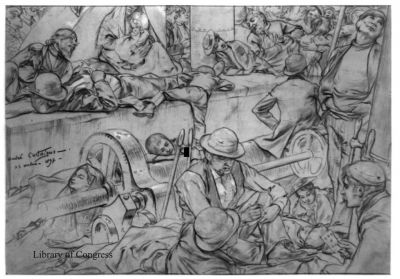Filippo Carosella, Filippo Marcovecchio and Alfonso Saulino along with wife Angela Maria, lived in Agnone. Of these, Filippo Carosella and Filippo Marcovecchio were contadini, or farmers, while Alfonso Saulino was a shoemaker. For all of them, as for many in southern Italy, and especially in Agnone, the 1870s were very difficult years. But despite all the challenges the four would face, they would eventually leave Italy and settle in the Mahoning Valley in 1873. Why did they abandon their native land and how did they arrive in the Greater Youngstown area?
Leaving Italy After Unification
The four Agnonesi would have experienced hardships similar to those that hit many Italians after Unification in 1870. The largely rural Kingdom of Italy faced several severe challenges, not least of which were a weak farming sector and lack of manufacturing. With the feudal system recently abolished, peasants lost the free use of village pastures, fields and woodlands. Additionally, by the second half of the 19th century, an expanding birth rate was outstripping the country’s ability to gainfully employ its workforce. The widespread areas that produced cereal crops, such as wheat and corn, were especially marked by an underemployed, seasonal labor force. Once the grain harvest was finished, there was very little chance for work elsewhere. For people like Alfonso and Angela Maria and the two Filippos, the future in Italy looked very bleak.
The situation in southern Italy, where Agnone was located, was even worse. Luigi Campanelli, longtime mayor of nearby Capracotta, recorded in his history, “Il Territorio di Capracotta,” a list of denunciations of the early central government. In it he inveighed against the country’s political leaders. He accused them of favoring northern Italy, increasing taxes on the population, imposing new rents on the sheepherding industry, exacerbating the problem of the brigands, and levying a tax on gristmills – effectively hiking the price of bread. Not surprisingly, many southerners joined Italians from other regions who were leaving. Previous immigration from Italy to the U.S. had been negligible, but by 1870, Italian immigrants arriving on the East Coast were reaching into the thousands.
Transmigration and a Hellish Voyage
Sailing to the U.S. from Italy and surviving the passage would be no small feat for the four from Agnone. While transatlantic vessels in the 1890s and later would depart from Genoa and Naples, in the earlier decades small and less reliable ocean-going ships made for a complicated and prolonged journey. Italians had to make a series of transmigrations across Northern Europe before actually embarking for the Americas. For southern Italians, the first stage in their journey was a trek from their homes to Naples, with the poorest among them arriving on foot. Once at the seaport, the travelers boarded a steamer bound for Marseilles on the southern coast of France. After a brief passage on the Mediterranean Sea, the travelers left the French port and continued overland by rail to Le Havre on the north coast of France. There the “transmigrants” embarked on a vessel bound for the United States.
But there were other challenges. The National Line was a shipping company with a record of fraud and abuse of passengers. Its vessel, the S. S. Erin, proved no exception. A vivid record of the steamer’s early December voyage of 1872 survives because of the eyewitness account of passenger Joseph P. McDonnell, a reporter for The New York Herald. He noted that no sooner had the vessel raised anchor than the first sign of trouble appeared. There were no sailors at the lifeboats.
The four Agnonesi boarded the Erin at Le Havre along with 750 passengers, 550 of whom were Italian emigrants.
The conclusion of “Local Italian American History: From Agnone to Hubbard Township” will be printed in our next issue.
The story of the S. S. Erin and its passengers from Agnone is taken from an unpublished study by Joe Tucciarone and Ben Lariccia, “The Coalburg Italians: Coal, Immigration, and Labor Strife in Ohio’s Mahoning Valley.”



